if you want to find stars that are just being born, where are the best places to search?
Learning Objectives
By the terminate of this section, you will exist able to:
- Place the sometimes-violent processes by which parts of a molecular cloud collapse to produce stars
- Recognize some of the structures seen in images of molecular clouds like the ane in Orion
- Explain how the environment of a molecular cloud enables the formation of stars
- Describe how advancing waves of star formation crusade a molecular deject to evolve
As we brainstorm our exploration of how stars are formed, permit's review some basics about stars discussed in earlier chapters:
- Stable (main-sequence) stars such as our Sun maintain equilibrium past producing free energy through nuclear fusion in their cores. The ability to generate energy by fusion defines a star.
- Each second in the Sun, approximately 600 1000000 tons of hydrogen undergo fusion into helium, with most 4 million tons turning into energy in the process. This rate of hydrogen use ways that eventually the Dominicus (and all other stars) will run out of cardinal fuel.
- Stars come up with many dissimilar masses, ranging from i/12 solar masses (Grand Dominicus) to roughly 100–200 M Sun. There are far more than depression-mass than high-mass stars.
- The most massive main-sequence stars (spectral type O) are also the most luminous and accept the highest surface temperature. The lowest-mass stars on the chief sequence (spectral type One thousand or Fifty) are the least luminous and the coolest.
- A galaxy of stars such as the Milky way contains enormous amounts of gas and dust—enough to brand billions of stars like the Sunday.
If we want to notice stars even so in the process of formation, we must look in places that have plenty of the raw cloth from which stars are assembled. Since stars are fabricated of gas, we focus our attention (and our telescopes) on the dense and cold clouds of gas and dust that dot the Galaxy (see Effigy 1).
 Effigy one: Pillars of Dust and Dumbo Globules in M16. (a) This Hubble Infinite Telescope image of the central regions of M16 (also known as the Eagle Nebula) shows huge columns of cool gas, (including molecular hydrogen, H2) and dust. These columns are of higher density than the surrounding regions and have resisted evaporation by the ultraviolet radiations from a cluster of hot stars just beyond the upper-right corner of this paradigm. The tallest colonnade is about 1 lite-year long, and the M16 region is virtually 7000 light-years abroad from us. (b) This close-up view of ane of the pillars shows some very dumbo globules, many of which harbor embryonic stars. Astronomers coined the term evaporating gas globules (EGGs) for these structures, in role so that they could say we found EGGs inside the Hawkeye Nebula. It is possible that because these EGGs are exposed to the relentless activity of the radiation from nearby hot stars, some may not yet have collected enough textile to class a star. (credit a : modification of piece of work by NASA, ESA, and the Hubble Heritage Team (STScI/Aureola); credit b: modification of piece of work by NASA, ESA, STScI, J. Hester and P. Scowen (Arizona State University))
Effigy one: Pillars of Dust and Dumbo Globules in M16. (a) This Hubble Infinite Telescope image of the central regions of M16 (also known as the Eagle Nebula) shows huge columns of cool gas, (including molecular hydrogen, H2) and dust. These columns are of higher density than the surrounding regions and have resisted evaporation by the ultraviolet radiations from a cluster of hot stars just beyond the upper-right corner of this paradigm. The tallest colonnade is about 1 lite-year long, and the M16 region is virtually 7000 light-years abroad from us. (b) This close-up view of ane of the pillars shows some very dumbo globules, many of which harbor embryonic stars. Astronomers coined the term evaporating gas globules (EGGs) for these structures, in role so that they could say we found EGGs inside the Hawkeye Nebula. It is possible that because these EGGs are exposed to the relentless activity of the radiation from nearby hot stars, some may not yet have collected enough textile to class a star. (credit a : modification of piece of work by NASA, ESA, and the Hubble Heritage Team (STScI/Aureola); credit b: modification of piece of work by NASA, ESA, STScI, J. Hester and P. Scowen (Arizona State University))
Molecular Clouds: Stellar Nurseries
Every bit we saw in Betwixt the Stars: Gas and Dust in Space, the near massive reservoirs of interstellar affair—and some of the most massive objects in the Milky Way Milky way—are the giant molecular clouds. These clouds have cold interiors with characteristic temperatures of just 10–xx K; most of their gas atoms are bound into molecules. These clouds turn out to be the birthplaces of nigh stars in our Galaxy.
The masses of molecular clouds range from a g times the mass of the Dominicus to about iii million solar masses. Molecular clouds take a circuitous filamentary structure, like to cirrus clouds in World'southward atmosphere, but much less dumbo. The molecular cloud filaments tin can be up to 1000 light-years long. Within the clouds are cold, dumbo regions with typical masses of l to 500 times the mass of the Dominicus; we give these regions the highly technical name clumps. Within these clumps, there are even denser, smaller regions called cores. The cores are the embryos of stars. The conditions in these cores—low temperature and high density—are but what is required to brand stars. Remember that the essence of the life story of any star is the ongoing competition between two forces: gravity and force per unit area. The force of gravity, pulling inward, tries to brand a star plummet. Internal pressure produced past the motions of the gas atoms, pushing outward, tries to force the star to expand. When a star is start forming, depression temperature (and hence, depression pressure) and loftier density (hence, greater gravitational allure) both work to give gravity the advantage. In order to course a star—that is, a dense, hot ball of matter capable of starting nuclear reactions deep within—we need a typical core of interstellar atoms and molecules to shrink in radius and increase in density by a factor of nearly 1020. It is the force of gravity that produces this drastic collapse.
The Orion Molecular Cloud
Allow's hash out what happens in regions of star formation by considering a nearby site where stars are forming correct now. One of the all-time-studied stellar nurseries is in the constellation of Orion, The Hunter, about 1500 light-years away (Effigy 2). The pattern of the hunter is easy to recognize by the conspicuous "belt" of three stars that mark his waist. The Orion molecular cloud is much larger than the star pattern and is truly an impressive construction. In its long dimension, it stretches over a distance of about 100 light-years. The total quantity of molecular gas is almost 200,000 times the mass of the Sun. Most of the cloud does not glow with visible light merely betrays its presence by the radiations that the dusty gas gives off at infrared and radio wavelengths.
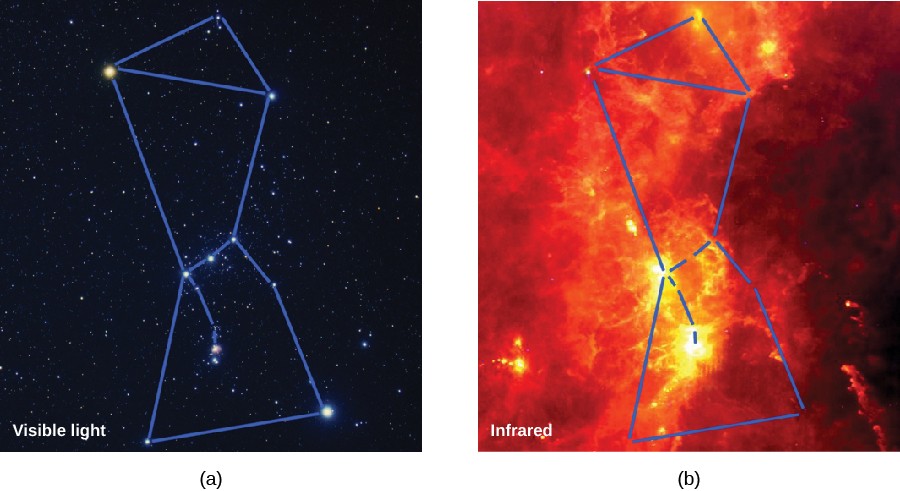 Figure 2: Orion in Visible and Infrared. (a) The Orion star group was named subsequently the legendary hunter in Greek mythology. Three stars shut together in a link mark Orion'south belt. The ancients imagined a sword hanging from the belt; the object at the end of the blue line in this sword is the Orion Nebula. (b) This broad-angle, infrared view of the same area was taken with the Infrared Astronomical Satellite. Heated dust clouds boss in this false-color image, and many of the stars that stood out on function (a) are now invisible. An exception is the absurd, red-behemothic star Betelgeuse, which tin be seen every bit a yellowish point at the left vertex of the blue triangle (at Orion's left armpit). The large, yellowish ring to the right of Betelgeuse is the remnant of an exploded star. The infrared image lets u.s. see how large and full of cooler material the Orion molecular cloud actually is. On the visible-light image at left, y'all run into only two colorful regions of interstellar matter—the two, brilliant xanthous splotches at the left cease of and beneath Orion's belt. The lower one is the Orion Nebula and the higher one is the region of the Horsehead Nebula. (credit: modification of work by NASA, visible calorie-free: Akira Fujii; infrared: Infrared Astronomical Satellite)
Figure 2: Orion in Visible and Infrared. (a) The Orion star group was named subsequently the legendary hunter in Greek mythology. Three stars shut together in a link mark Orion'south belt. The ancients imagined a sword hanging from the belt; the object at the end of the blue line in this sword is the Orion Nebula. (b) This broad-angle, infrared view of the same area was taken with the Infrared Astronomical Satellite. Heated dust clouds boss in this false-color image, and many of the stars that stood out on function (a) are now invisible. An exception is the absurd, red-behemothic star Betelgeuse, which tin be seen every bit a yellowish point at the left vertex of the blue triangle (at Orion's left armpit). The large, yellowish ring to the right of Betelgeuse is the remnant of an exploded star. The infrared image lets u.s. see how large and full of cooler material the Orion molecular cloud actually is. On the visible-light image at left, y'all run into only two colorful regions of interstellar matter—the two, brilliant xanthous splotches at the left cease of and beneath Orion's belt. The lower one is the Orion Nebula and the higher one is the region of the Horsehead Nebula. (credit: modification of work by NASA, visible calorie-free: Akira Fujii; infrared: Infrared Astronomical Satellite)
The stars in Orion'south belt are typically almost 5 1000000 years old, whereas the stars near the heart of the "sword" hanging from Orion's belt are only 300,000 to 1 one thousand thousand years onetime. The region about halfway down the sword where star formation is nevertheless taking place is called the Orion Nebula. Nearly 2200 young stars are constitute in this region, which is only slightly larger than a dozen light-years in diameter. The Orion Nebula also contains a tight cluster of stars chosen the Trapezium (Effigy iv). The brightest Trapezium stars tin be seen easily with a small telescope.
 Effigy three: Orion Nebula. (a) The Orion Nebula is shown in visible light. (b) With about-infrared radiation, we tin can run across more detail inside the dusty nebula since infrared can penetrate dust more easily than can visible calorie-free. (credit a: modification of work by Filip Lolić; credit b: modification of work by NASA/JPL-Caltech/T. Megeath (University of Toledo, Ohio))
Effigy three: Orion Nebula. (a) The Orion Nebula is shown in visible light. (b) With about-infrared radiation, we tin can run across more detail inside the dusty nebula since infrared can penetrate dust more easily than can visible calorie-free. (credit a: modification of work by Filip Lolić; credit b: modification of work by NASA/JPL-Caltech/T. Megeath (University of Toledo, Ohio))
Compare this with our ain solar neighborhood, where the typical spacing between stars is well-nigh 3 low-cal-years. Only a minor number of stars in the Orion cluster tin be seen with visible light, but infrared images—which penetrate the grit better—detect the more than than 2000 stars that are part of the grouping (Effigy iv).
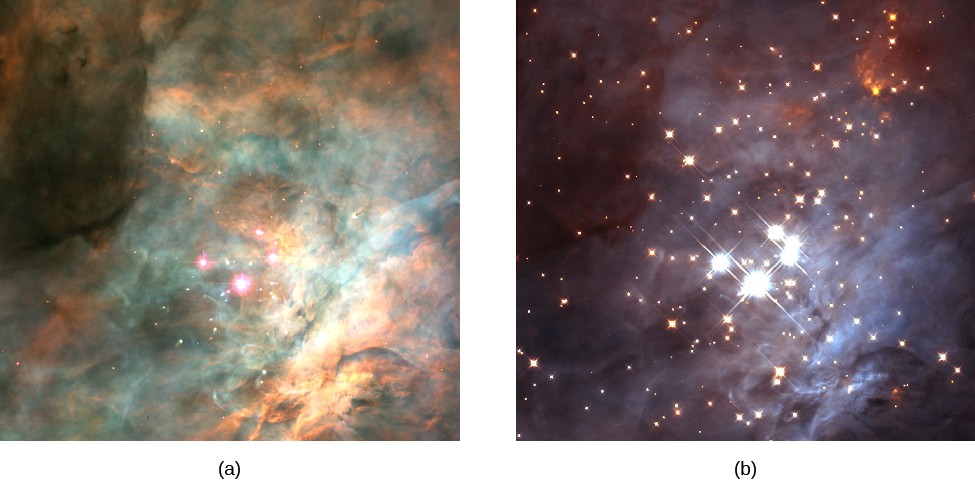 Figure 4: Fundamental Region of the Orion Nebula. The Orion Nebula harbors some of the youngest stars in the solar neighborhood. At the heart of the nebula is the Trapezium cluster, which includes 4 very bright stars that provide much of the energy that causes the nebula to glow and then brightly. In these images, we see a section of the nebula in (a) visible low-cal and (b) infrared. The four brilliant stars in the center of the visible-light paradigm are the Trapezium stars. Notice that nearly of the stars seen in the infrared are completely hidden past dust in the visible-light epitome. (credit a: modification of work past NASA, C.R. O'Dell and Southward.K. Wong (Rice University); credit b: modification of work past NASA; K.Fifty. Luhman (Harvard-Smithsonian Middle for Astrophysics); and G. Schneider, Due east. Young, Thousand. Rieke, A. Cotera, H. Chen, Grand. Rieke, R. Thompson (Steward Observatory, University of Arizona))
Figure 4: Fundamental Region of the Orion Nebula. The Orion Nebula harbors some of the youngest stars in the solar neighborhood. At the heart of the nebula is the Trapezium cluster, which includes 4 very bright stars that provide much of the energy that causes the nebula to glow and then brightly. In these images, we see a section of the nebula in (a) visible low-cal and (b) infrared. The four brilliant stars in the center of the visible-light paradigm are the Trapezium stars. Notice that nearly of the stars seen in the infrared are completely hidden past dust in the visible-light epitome. (credit a: modification of work past NASA, C.R. O'Dell and Southward.K. Wong (Rice University); credit b: modification of work past NASA; K.Fifty. Luhman (Harvard-Smithsonian Middle for Astrophysics); and G. Schneider, Due east. Young, Thousand. Rieke, A. Cotera, H. Chen, Grand. Rieke, R. Thompson (Steward Observatory, University of Arizona))
Studies of Orion and other star-forming regions testify that star formation is not a very efficient process. In the region of the Orion Nebula, almost 1% of the material in the cloud has been turned into stars. That is why we still run across a substantial corporeality of gas and grit nearly the Trapezium stars. The leftover material is eventually heated, either by the radiation and winds from the hot stars that form or by explosions of the most massive stars. (We will come across in later on chapters that the well-nigh massive stars get through their lives very quickly and stop by exploding.)
Take a journey through the Orion Nebula to view a overnice narrated video bout of this region.
Whether gently or explosively, the material in the neighborhood of the new stars is blown away into interstellar infinite. Older groups or clusters of stars can now be hands observed in visible calorie-free because they are no longer shrouded in grit and gas (Figure 5).
 Figure 5: Westerlund ii. This young cluster of stars known every bit Westerlund ii formed inside the Carina star-forming region about 2 meg years agone. Stellar winds and force per unit area produced past the radiation from the hot stars within the cluster are blowing and sculpting the surrounding gas and dust. The nebula however contains many globules of dust. Stars are continuing to form inside the denser globules and pillars of the nebula. This Hubble Space Telescope image includes nearly-infrared exposures of the star cluster and visible-light observations of the surrounding nebula. Colors in the nebula are dominated by the red glow of hydrogen gas, and blue-green emissions from glowing oxygen. (credit: NASA, ESA, the Hubble Heritage Team (STScI/Aureola), A. Nota (ESA/STScI), and the Westerlund 2 Science Squad)
Figure 5: Westerlund ii. This young cluster of stars known every bit Westerlund ii formed inside the Carina star-forming region about 2 meg years agone. Stellar winds and force per unit area produced past the radiation from the hot stars within the cluster are blowing and sculpting the surrounding gas and dust. The nebula however contains many globules of dust. Stars are continuing to form inside the denser globules and pillars of the nebula. This Hubble Space Telescope image includes nearly-infrared exposures of the star cluster and visible-light observations of the surrounding nebula. Colors in the nebula are dominated by the red glow of hydrogen gas, and blue-green emissions from glowing oxygen. (credit: NASA, ESA, the Hubble Heritage Team (STScI/Aureola), A. Nota (ESA/STScI), and the Westerlund 2 Science Squad)
Although nosotros do non know what initially acquired stars to begin forming in Orion, there is expert show that the first generation of stars triggered the formation of boosted stars, which in plow led to the formation of still more than stars (Figure six).
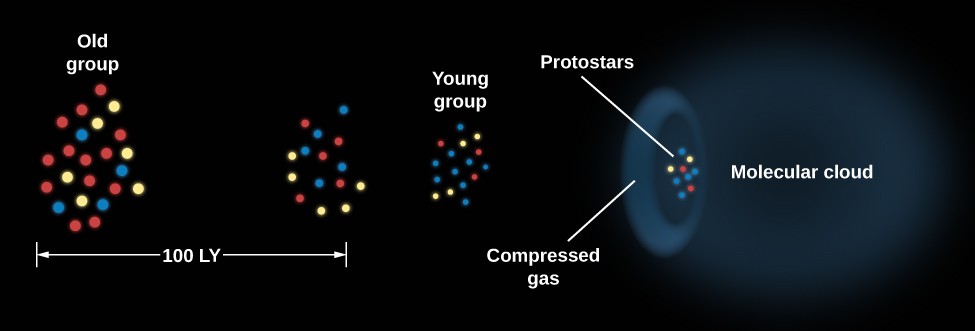 Figure 6: Propagating Star Formation. Star formation tin can move progressively through a molecular deject. The oldest group of stars lies to the left of the diagram and has expanded because of the motions of individual stars. Somewhen, the stars in the group will disperse and no longer be recognizable as a cluster. The youngest group of stars lies to the correct, side by side to the molecular cloud. This group of stars is only ane to 2 million years old. The pressure of the hot, ionized gas surrounding these stars compresses the material in the nearby edge of the molecular deject and initiates the gravitational collapse that will lead to the formation of more stars.
Figure 6: Propagating Star Formation. Star formation tin can move progressively through a molecular deject. The oldest group of stars lies to the left of the diagram and has expanded because of the motions of individual stars. Somewhen, the stars in the group will disperse and no longer be recognizable as a cluster. The youngest group of stars lies to the correct, side by side to the molecular cloud. This group of stars is only ane to 2 million years old. The pressure of the hot, ionized gas surrounding these stars compresses the material in the nearby edge of the molecular deject and initiates the gravitational collapse that will lead to the formation of more stars.
The basic idea of triggered star germination is this: when a massive star is formed, information technology emits a large corporeality of ultraviolet radiation and ejects high-speed gas in the course of a stellar wind. This injection of energy heats the gas around the stars and causes it to expand. When massive stars exhaust their supply of fuel, they explode, and the energy of the explosion also heats the gas. The hot gases pile into the surrounding cold molecular deject, compressing the cloth in it and increasing its density. If this increase in density is large enough, gravity will overcome force per unit area, and stars will begin to course in the compressed gas. Such a chain reaction—where the brightest and hottest stars of ane area become the cause of star formation "next door"—seems to take occurred non only in Orion but likewise in many other molecular clouds.
At that place are many molecular clouds that form merely (or mainly) low-mass stars. Because depression-mass stars do not have potent winds and do not die by exploding, triggered star formation cannot occur in these clouds. At that place are likewise stars that class in relative isolation in small cores. Therefore, not all star formation is originally triggered by the death of massive stars. However, at that place are likely to be other possible triggers, such equally screw density waves and other processes nosotros do not even so sympathize.
The Birth of a Star
Although regions such every bit Orion give us clues about how star formation begins, the subsequent stages are still shrouded in mystery (and a lot of dust). At that place is an enormous difference betwixt the density of a molecular cloud core and the density of the youngest stars that tin can exist detected. Direct observations of this plummet to college density are well-nigh impossible for two reasons. Outset, the grit-shrouded interiors of molecular clouds where stellar births take place cannot be observed with visible light. 2d, the timescale for the initial plummet—thousands of years—is very short, astronomically speaking. Since each star spends such a tiny fraction of its life in this phase, relatively few stars are going through the plummet procedure at any given time. Nevertheless, through a combination of theoretical calculations and the express observations available, astronomers take pieced together a moving-picture show of what the primeval stages of stellar evolution are likely to exist.
The first step in the process of creating stars is the formation of dense cores inside a dodder of gas and dust (Figure vii(a)). It is generally thought that all the material for the star comes from the core, the larger construction surrounding the forming star. Eventually, the gravitational force of the infalling gas becomes strong plenty to overwhelm the pressure exerted by the common cold material that forms the dense cores. The material then undergoes a rapid collapse, and the density of the core increases greatly as a result. During the fourth dimension a dense core is contracting to become a true star, but earlier the fusion of protons to produce helium begins, nosotros call the object a protostar.
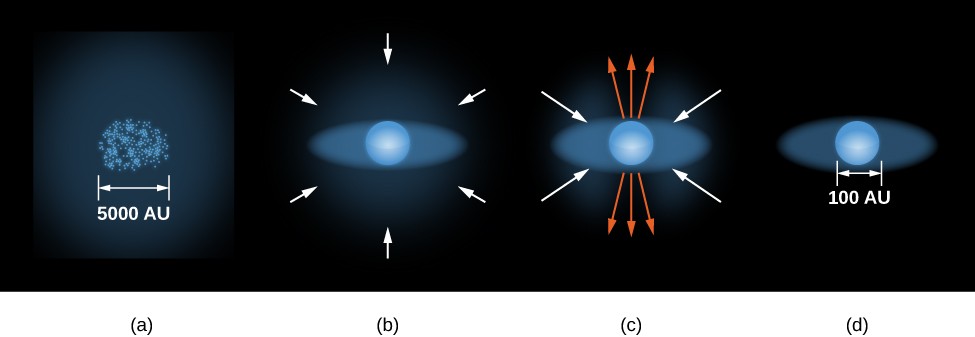 Figure vii: Germination of a Star. (a) Dumbo cores form within a molecular cloud. (b) A protostar with a surrounding deejay of material forms at the eye of a dense core, accumulating additional material from the molecular cloud through gravitational attraction. (c) A stellar air current breaks out but is confined by the disk to period out along the two poles of the star. (d) Eventually, this current of air sweeps away the cloud cloth and halts the accumulation of boosted material, and a newly formed star, surrounded by a disk, becomes appreciable. These sketches are not drawn to the aforementioned scale. The diameter of a typical envelope that is supplying gas to the newly forming star is about 5000 AU. The typical diameter of the disk is almost 100 AU or slightly larger than the diameter of the orbit of Pluto.
Figure vii: Germination of a Star. (a) Dumbo cores form within a molecular cloud. (b) A protostar with a surrounding deejay of material forms at the eye of a dense core, accumulating additional material from the molecular cloud through gravitational attraction. (c) A stellar air current breaks out but is confined by the disk to period out along the two poles of the star. (d) Eventually, this current of air sweeps away the cloud cloth and halts the accumulation of boosted material, and a newly formed star, surrounded by a disk, becomes appreciable. These sketches are not drawn to the aforementioned scale. The diameter of a typical envelope that is supplying gas to the newly forming star is about 5000 AU. The typical diameter of the disk is almost 100 AU or slightly larger than the diameter of the orbit of Pluto.
The natural turbulence inside a dodder tends to give whatever portion of information technology some initial spinning motion (even if information technology is very deadening). Equally a result, each collapsing core is expected to spin. According to the police force of conservation of angular momentum (discussed in the chapter on Orbits and Gravity), a rotating body spins more quickly equally it decreases in size. In other words, if the object tin plow its material around a smaller circle, it can move that material more quickly—like a figure skater spinning more than quickly as she brings her arms in tight to her body. This is exactly what happens when a cadre contracts to form a protostar: as it shrinks, its charge per unit of spin increases.
But all directions on a spinning sphere are non created equal. As the protostar rotates, information technology is much easier for material to fall right onto the poles (which spin almost slowly) than onto the equator (where textile moves around almost rapidly). Therefore, gas and dust falling in toward the protostar's equator are "held back" by the rotation and form a whirling extended deejay around the equator (part b in Effigy seven). Yous may have observed this aforementioned "equator effect" on the amusement park ride in which you stand with your back to a cylinder that is spun faster and faster. As you spin really fast, yous are pushed confronting the wall so strongly that yous cannot possibly fall toward the center of the cylinder. Gas can, still, fall onto the protostar easily from directions away from the star's equator.
The protostar and deejay at this stage are embedded in an envelope of dust and gas from which cloth is still falling onto the protostar. This dusty envelope blocks visible calorie-free, but infrared radiation can get through. As a effect, in this stage of its evolution, the protostar itself is emitting infrared radiation and then is observable simply in the infrared region of the spectrum. Once almost all of the available cloth has been accreted and the cardinal protostar has reached almost its final mass, it is given a special proper name: it is called a T Tauri star, named after one of the best studied and brightest members of this class of stars, which was discovered in the constellation of Taurus. (Astronomers take a tendency to proper name types of stars afterwards the first example they detect or come to empathise. It'due south not an elegant system, but it works.) Only stars with masses less than or similar to the mass of the Sun become T Tauri stars. Massive stars do not become through this stage, although they practise appear to follow the germination scenario illustrated in Effigy seven.
Winds and Jets
Recent observations suggest that T Tauri stars may actually be stars in a center stage betwixt protostars and hydrogen-fusing stars such equally the Sun. Loftier-resolution infrared images have revealed jets of material too as stellar winds coming from some T Tauri stars, proof of interaction with their environment. A stellar wind consists mainly of protons (hydrogen nuclei) and electrons streaming away from the star at speeds of a few hundred kilometers per second (several hundred thousand miles per hour). When the wind beginning starts upward, the disk of fabric around the star's equator blocks the wind in its direction. Where the wind particles can escape most effectively is in the management of the star's poles.
Astronomers take actually seen evidence of these beams of particles shooting out in opposite directions from the popular regions of newly formed stars. In many cases, these beams point dorsum to the location of a protostar that is still so completely shrouded in dust that we cannot withal see it (Figure 8).
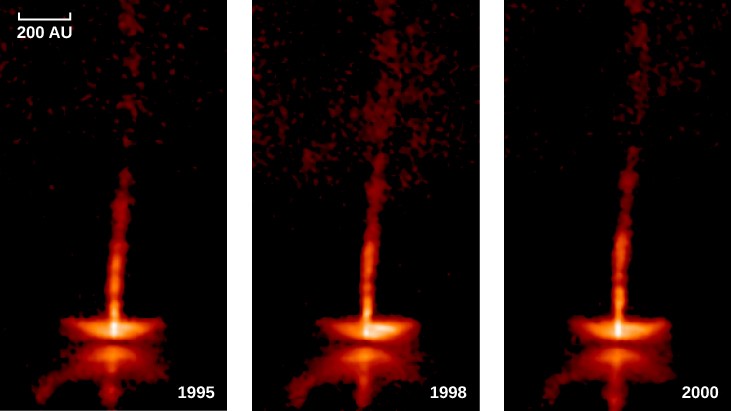 Figure 8: Gas Jets Flowing away from a Protostar. Here we see the neighborhood of a protostar, known to us as HH 34 because it is a Herbig-Haro object. The star is about 450 light-years away and only about 1 million years old. Light from the star itself is blocked by a deejay, which is larger than 60 billion kilometers in bore and is seen almost edge-on. Jets are seen emerging perpendicular to the disk. The material in these jets is flowing outward at speeds up to 580,000 kilometers per hour. The series of 3 images shows changes during a period of 5 years. Every few months, a compact dodder of gas is ejected, and its motion outward can exist followed. The changes in the brightness of the disk may be due to motions of clouds within the deejay that alternately cake some of the light so let information technology through. This prototype corresponds to the phase in the life of a protostar shown in part (c) of Effigy 7. (credit: modification of work past Hubble Space Telescope, NASA, ESA)
Figure 8: Gas Jets Flowing away from a Protostar. Here we see the neighborhood of a protostar, known to us as HH 34 because it is a Herbig-Haro object. The star is about 450 light-years away and only about 1 million years old. Light from the star itself is blocked by a deejay, which is larger than 60 billion kilometers in bore and is seen almost edge-on. Jets are seen emerging perpendicular to the disk. The material in these jets is flowing outward at speeds up to 580,000 kilometers per hour. The series of 3 images shows changes during a period of 5 years. Every few months, a compact dodder of gas is ejected, and its motion outward can exist followed. The changes in the brightness of the disk may be due to motions of clouds within the deejay that alternately cake some of the light so let information technology through. This prototype corresponds to the phase in the life of a protostar shown in part (c) of Effigy 7. (credit: modification of work past Hubble Space Telescope, NASA, ESA)
On occasion, the jets of high-speed particles streaming abroad from the protostar collide with a somewhat-denser lump of gas nearby, excite its atoms, and cause them to emit light. These glowing regions, each of which is known as a Herbig-Haro (HH) object afterward the ii astronomers who first identified them, let us to trace the progress of the jet to a altitude of a low-cal-yr or more than from the star that produced information technology. Figure nine shows two spectacular images of HH objects.
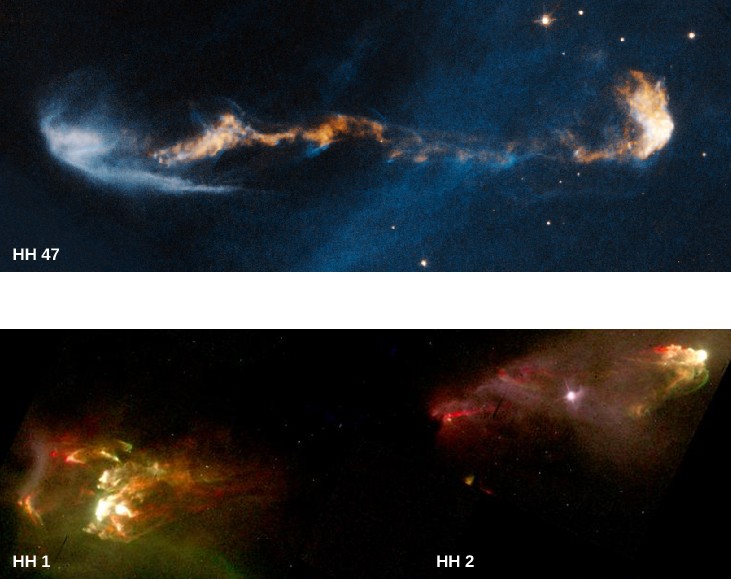 Figure 9: Outflows from Protostars. These images were taken with the Hubble Space Telescope and show jets flowing outward from newly formed stars. In the HH47 prototype, a protostar 1500 light-years away (invisible within a dust disk at the left edge of the paradigm) produces a very complicated jet. The star may actually be wobbling, perhaps because it has a companion. Calorie-free from the star illuminates the white region at the left because light can emerge perpendicular to the deejay (just as the jet does). At right, the jet is plowing into existing clumps of interstellar gas, producing a shock wave that resembles an arrowhead. The HH1/two prototype shows a double-beam jet emanating from a protostar (hidden in a dust disk in the center) in the constellation of Orion. Tip to tip, these jets are more than than ane light-yr long. The bright regions (first identified past Herbig and Haro) are places where the jet is a slamming into a clump of interstellar gas and causing it to glow. (credit "HH 47": modification of piece of work by NASA, ESA, and P. Hartigan (Rice University); credit "HH 1 and HH ii: modification of piece of work past J. Hester, WFPC2 Team, NASA)
Figure 9: Outflows from Protostars. These images were taken with the Hubble Space Telescope and show jets flowing outward from newly formed stars. In the HH47 prototype, a protostar 1500 light-years away (invisible within a dust disk at the left edge of the paradigm) produces a very complicated jet. The star may actually be wobbling, perhaps because it has a companion. Calorie-free from the star illuminates the white region at the left because light can emerge perpendicular to the deejay (just as the jet does). At right, the jet is plowing into existing clumps of interstellar gas, producing a shock wave that resembles an arrowhead. The HH1/two prototype shows a double-beam jet emanating from a protostar (hidden in a dust disk in the center) in the constellation of Orion. Tip to tip, these jets are more than than ane light-yr long. The bright regions (first identified past Herbig and Haro) are places where the jet is a slamming into a clump of interstellar gas and causing it to glow. (credit "HH 47": modification of piece of work by NASA, ESA, and P. Hartigan (Rice University); credit "HH 1 and HH ii: modification of piece of work past J. Hester, WFPC2 Team, NASA)
The wind from a forming star will ultimately sweep away the material that remains in the obscuring envelope of dust and gas, leaving behind the naked disk and protostar, which can and then be seen with visible light. We should note that at this betoken, the protostar itself is however contracting slowly and has not yet reached the chief-sequence stage on the H–R diagram (a concept introduced in the chapter The Stars: A Celestial Census). The disk can be detected straight when observed at infrared wavelengths or when it is seen silhouetted against a bright background (Effigy x).
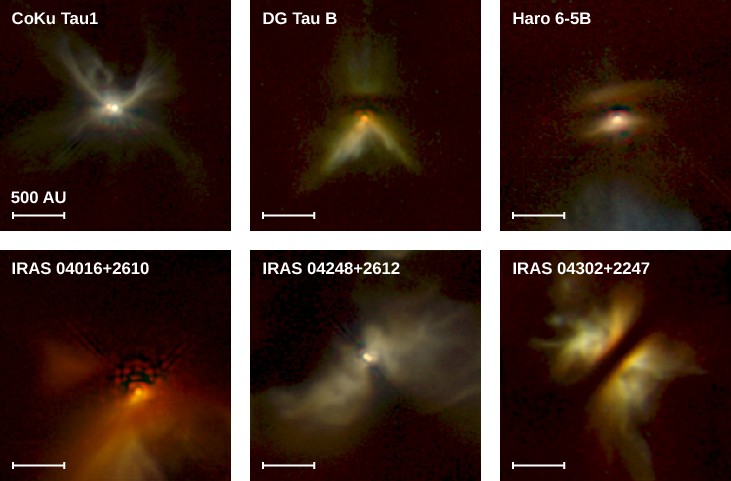 Figure 10: Disks around Protostars. These Hubble Space Telescope infrared images evidence disks around young stars in the constellation of Taurus, in a region about 450 light-years away. In some cases, we can run into the primal star (or stars—some are binaries). In other cases, the dark, horizontal bands betoken regions where the dust disk is so thick that fifty-fifty infrared radiation from the star embedded within it cannot make its way through. The brightly glowing regions are starlight reflected from the upper and lower surfaces of the deejay, which are less dense than the central, dark regions. (Credit: modification of work past D. Padgett (IPAC/Caltech), W. Brandner (IPAC), K. Stapelfeldt (JPL) and NASA)
Figure 10: Disks around Protostars. These Hubble Space Telescope infrared images evidence disks around young stars in the constellation of Taurus, in a region about 450 light-years away. In some cases, we can run into the primal star (or stars—some are binaries). In other cases, the dark, horizontal bands betoken regions where the dust disk is so thick that fifty-fifty infrared radiation from the star embedded within it cannot make its way through. The brightly glowing regions are starlight reflected from the upper and lower surfaces of the deejay, which are less dense than the central, dark regions. (Credit: modification of work past D. Padgett (IPAC/Caltech), W. Brandner (IPAC), K. Stapelfeldt (JPL) and NASA)
This description of a protostar surrounded by a rotating disk of gas and dust sounds very much similar what happened in our solar organization when the Sun and planets formed. Indeed, one of the most important discoveries from the study of star formation in the last decade of the twentieth century was that disks are an inevitable byproduct of the process of creating stars. The side by side questions that astronomers prepare out to answer was: will the disks effectually protostars too course planets? And if so, how often? We will return to these questions later in this chapter.
To keep things simple, we have described the formation of single stars. Many stars, withal, are members of binary or triple systems, where several stars are born together. In this case, the stars form in nearly the same mode. Widely separated binaries may each have their own disk; close binaries may share a single disk.
Key concepts and summary
Near stars class in giant molecular clouds with masses as big equally iii × 10half dozen solar masses. The almost well-studied molecular cloud is Orion, where star formation is currently taking place. Molecular clouds typically contain regions of higher density chosen clumps, which in turn comprise several even-denser cores of gas and dust, each of which may become a star. A star tin can form within a cadre if its density is high enough that gravity tin can overwhelm the internal pressure level and crusade the gas and dust to collapse. The accumulation of material halts when a protostar develops a stiff stellar air current, leading to jets of material being observed coming from the star. These jets of material can collide with the material around the star and produce regions that emit calorie-free that are known as Herbig-Haro objects.
Glossary
giant molecular clouds: large, common cold interstellar clouds with diameters of dozens of light-years and typical masses of 10v solar masses; found in the spiral arms of galaxies, these clouds are where stars form
Herbig-Haro (HH) object: luminous knots of gas in an surface area of star formation that are ready to glow past jets of material from a protostar
protostar: a very young star still in the procedure of formation, before nuclear fusion begins
stellar wind: the outflow of gas, sometimes at speeds as high as hundreds of kilometers per second, from a star
Licenses and Attributions
Source: https://courses.lumenlearning.com/astronomy/chapter/star-formation/
Posted by: griffiththerret99.blogspot.com

0 Response to "if you want to find stars that are just being born, where are the best places to search?"
Post a Comment